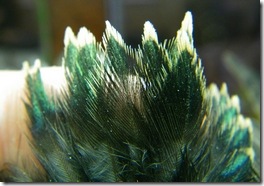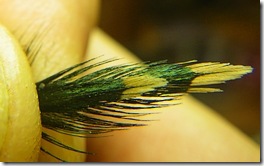At times I think even PETA hates starlings, universally reviled – it seems even little old ladies consider them cockroaches of the sky …
When I lived in the woods the local rice farmers would pay for your ammo, sending great groups of killers onto the paddies to blow hell out of yellow-hooded and redwing blackbirds. I tried desperately to come up with fly patterns that would allow for an orderly disposal of so many carcasses and failed miserably…
… something about black makes it an absolute must-have – but like licorice, you “must-have” in small doses …
Having re-upped the half dozen skins I keep around, and flush with small, soft black hackle – I’m reminded of all the other uses it was put to back in the day…

Strangely enough outside of using it for black hackle on all forms of sinking flies, mostly I used it as Poor Man’s Jungle Cock …

Most of the hackle feathers on the back and shoulders have a nicely defined yellow tip. Grab a pair of them and slide one down about a quarter inch …
 A bit of wax or vinyl head cement (flexible) is all that’s needed to transform a tawdry little bird into something a rich kid that likes flutes is willing to steal for …
A bit of wax or vinyl head cement (flexible) is all that’s needed to transform a tawdry little bird into something a rich kid that likes flutes is willing to steal for …
… knowing where he’s headed we’ll observe a brief moment of solemn knowing his fly tying is bound to suffer in the face of the sudden demand for his flautist skills …

My son who paints well (canvas rather than bricks and mortars) recently said to me “never use black, never, never, absolutely never use black.” He was talking about painting (an oil portrait) but I wonder, and given what you mention above, and aside from truly black flies, whether black should really be “dark,” as starling feathers seem to be, rather than true black. My son was implying that you can get dark in various hues but black is absolute and irretrievable. So I was curious how much this may hold for fly tying too.
Black offers the most distinct silouette when underwater and at any depth. As underwater flies go it’s an essential color – much more important than a black dry fly.
The venerable Black Gnat has covered for hundreds of dark dry flies for at least 100 years, but you’d be hard pressed to think of another black dry fly.
Given that the fish are gazing upward (possibly) at the time of dry fly inhalation, I would assume most flies would be dark (as the Sun and bright sky is behind them). Perhaps a trained artist can shed light on the conundrum.
Pingback: Tweets that mention Where we pay a little homage to the cockroach of the Skies | Singlebarbed -- Topsy.com
Pingback: No legislation needed your Honor, I’ll handle this trifling outbreak | Singlebarbed